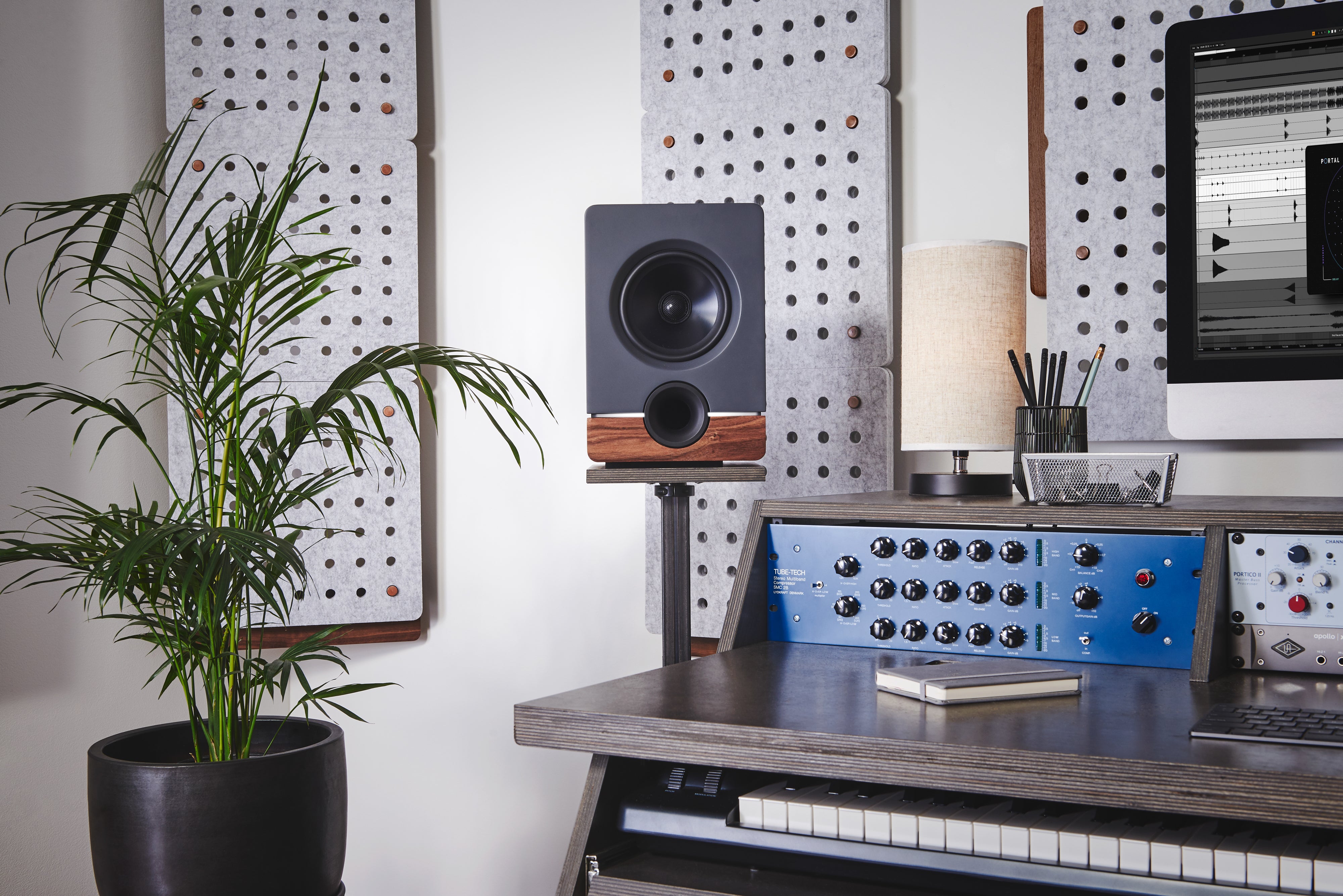Introduction
As you’ve likely gathered, environmental concerns around the sustainability of creators is a major reason why De-Fi exists, however, if the products aren’t actually good at what they set out to be, then what’s the point? Even if we do our level best to follow the three R’s (Reduce, reuse and recycle.), the products we create still take energy to make, and have to be transported, so they better be a net positive as far as function, and be worth the effort. This article is an explanation toward that end, with a bit of a deeper dive on the philosophy behind our choices on elements that determined the performance of our acoustic panels.
Open Designs
One of the benefits of following the three R’s is that one of those R’s is reduce, and sleeker things tend to be more aesthetically pleasing which was important to us. It also led us to explore open acoustic designs, which we discovered can be very effective in taming sound. The conventional wisdom in acoustic treatment is that bigger is better. People pile up massive amounts of material creating things literally called superchunks trying to absorb sound, when just being intelligent with air gaps, the size of those gaps, and materials, can accomplish the same thing. Most modern soundproof rooms aren’t made soundproof with two feet of concrete, they do it with decoupling and air gaps, and while soundproofing isn’t our goal—attenuation is—the same principles apply.
Decoupling and air gaps also allowed us to view the solutions like we would view a transducer design, but instead of producing sound like a speaker, or catching sound like a microphone diaphragm, the systems are designed to catch sound like big diaphragms and absorb it.
We also designed De-Fi Absorbers with specific air gaps and small attachment points to decouple the panels from the walls. Not only do these gaps effectively increase the surface area absorbing energy (front and back), they lower the effective range of the absorbers, by functioning like small traps, that trap frequencies associated with pitch, and not just reflective frequencies associated with sibilance, like most flush wall mounted solutions. The size of the air gaps allowed behind the panels are not arbitrary. The minimum and maximum distance allowed was determined by a distance that would allow trapping of mid range frequencies, without being so large as to no longer trap anything. The minimum air gap allowed by the De-Fi Absorbers is 50mm, and the maximum is 70mm, which using the quarter wavelength rule, are associated with pitches on the sixth octave of a piano, which are not frequencies we want bouncing around and ringing. This range of air gap is also very effective when in the cloud configuration. We tested lowering the panels to be more like an angled, classic cloud, but found that the panels were much less effective if we greatly increased the air gap to accommodate that configuration.
This open design on the De-Fi Absorbers also allow for customization of the amount of absorption desired by stacking panels. This allows not only customization at purchase, it allows easy customization while using (remove panels if you want a more live recording), and allows later upgrade opportunities by building on what you already have purchased. There’s no starting over and throwing away.
In addition, we didn’t want to create more chambers, which sealed solutions tend to do. Your room is a chamber that we’re trying to tame. Your speakers/studio monitors are chambers that are designed to enhance themselves. The air inside of a speaker is basically a spring pushing and pulling against the moving drivers, with the vent, or lack thereof, determining the tightness of the spring. The volume of the air behind the driver, size of the vent, or lack thereof, is all taken into account to optimize that specific system. It’s not a one size fits all kind of thing. Along those same lines, if your room is one chamber, and we are going to introduce another chamber into the equation to fix issues with your room, with say, a sealed bass trap, that little chamber better be specifically designed with the correct volume, tightness of spring (size of vent and tightness of whatever mass is doing the absorbing), and resonant frequency to take of the issues specific to your room, or it’s not going to be very efficient.
Taking the above into account, we designed the De-Fi Bass Trap as an open system to be more sympathetic to a wider array of energy, without a specific frequency. It’s more flexible dealing with the chamber it’s in. The acoustic mass in the Bass Trap is limply suspended, mostly decoupled from the walls, and openly suspended for that reason. It’s very effective, so much so that we patented the design. If sealed acoustic solutions are like falling on a trampoline, the De-Fi solution is like falling into a trapeze net. Think of it like a reverse two way speaker—what makes it reverse is instead of producing sound, it absorbs it, with the Eco Acoustic Panels absorbing the tweeter frequencies, and the acoustic mass absorbing the woofer frequencies.
The Diffuser is an open quadratic design because those designs can be tuned to certain frequencies with the dimensions of the front wells. We also found that by leaving the side baffles open with the angled slats, and allowing sound in behind the outer wells, we added distances that act much like the front wells, that improve its overall effectiveness. The angled outer slats reflect higher frequencies in different directions, more than just using the wells in basic quadratic designs.
Conclusion
Ideally, a fully treated room should incorporate all of our products, because our products, and the frequencies that they handle, were purposefully designed to work together and designed with actual musical pitches in mind, with a focus on problem frequencies that we encounter when mixing, recording and critical listening. While any of our products used alone will help, using all of them will cover the entire audible range. We also did not want to overwhelm with choice, so we endeavored to accomplish a full room system with fewer products. We’re confident that our choices will not only make your room look better, but sound much better.
Tech Specs
Wall treatment is measured using Noise Reduction Coefficients. On this scale, 0 represents no sound being absorbed, and 1 represents all sound being absorbed at a certain frequency range. However, due to testing parameters and conditions, you will often see ratings higher than 1. In general, a higher number is better.
When you see a single number for a product that does not show corresponding frequencies, it’s the average of the product between 100Hz to 5kHz. Keep this in mind and make sure to check a product’s absorption curve with listed absorption coefficients per octave, because a product with a broader range but lower averaged NRC will perform better in the real world than a product with a very high absorption coefficient at a single octave skewing the entire NRC average upward.
A single stack Absorber has an NRC of 0.8, which is what most 2” thick solutions are rated, and a double stack Absorber has an NRC of 0.9, which is equivalent with most 3” thick solutions.
The Diffuser is tuned to be most effective between 847Hz to 3.4kHz.
De-Fi NRC Ratings & Effective Frequency Range






